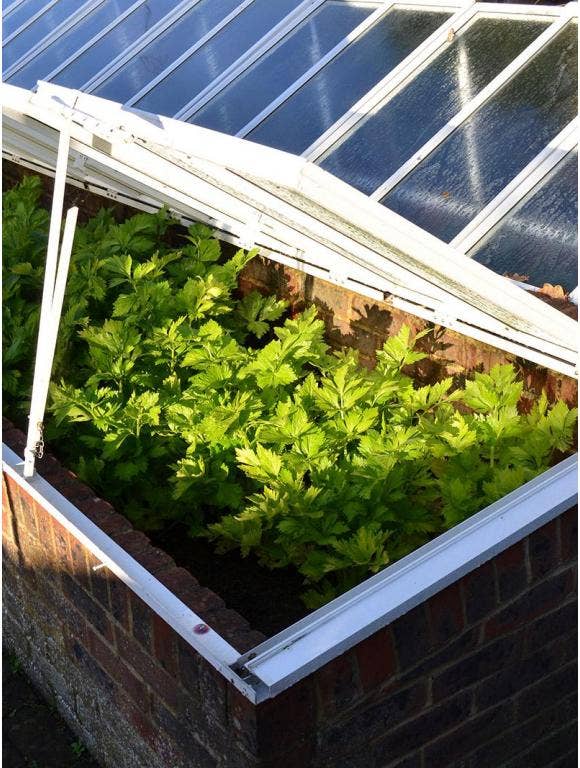
These common questions may come to mind, especially if you live in cooler climates. If you're looking to get a head start on your garden next spring or protect your fall garden from frost but have limited space for a full-size greenhouse, look no further than the versatile cold frame.
What Is a Cold Frame?
Simply put, cold frames are small greenhouses that come in a variety of styles, materials and sizes. Most are simple plastic enclosures with removable lids to allow for the dissipation of heat and increased airflow. These ready-made and easy-to-assemble cold frames are perfect if you want to keep a neat and tidy look. You can also create a cold frame yourself, using hay bales and old windows. Use the hay bales as a foundation and place the windows on top. Alternatively, you could use wood, bricks or cinder blocks in lieu of hay bales.
When Can You Use a Cold Frame?
Cold frames work great if you want to get plants in the ground before the last frost. Because of their user-friendly build and typically small sizes, these structures can easily fit into any location. Choose a spot that receives plenty of sunlight throughout the day, which will warm the cold frame's interior and allow it to hold onto the heat longer into the evening. Even on cloudy days, cold frames trap heat and humidity. These structures are also typically easy to assemble and disassemble, meaning they can be used to start plants such as seedlings, then removed and stored for the remainder of the season.
If you live in a northern climate with cold winters, cold frames are best suited for use in spring but can also be used in the fall to extend some shorter, warm season crops. If you live in a warmer climate, cold frames can be used year-round to keep frost off plants and keep cool season plants growing throughout the chillier months of fall, winter and early spring.
What Can You Grow in a Cold Frame?
Cold frames are excellent if you want to start seeds and/or grow shorter plants that'll easily fit under glass for at least a month or so until the last frost. Keep in mind that as the seasons progress, plants will outgrow most cold frames once they're well established, so you'll want to keep an eye on them and adjust accordingly.
Cold frames not only limit the height of plants you can grow, but they also require a few changes to how you grow plants. Just as with growing plants in a greenhouse, growing plants in a cold frame will keep ambient humidity and temperatures higher than the surrounding atmosphere, which is great for starting seeds and getting seedlings going. However, because of the higher humidity and warmer temperatures, be sure to protect your plants from extremes. It's easy to maintain the correct temperature in a cold frame because of its simple construction: Just open up a portion of the cold frame to allow air to circulate if the interior gets too warm. Opening up a portion of the structure is also important to harden off seedlings and mature plants alike.


What Pests Should You Look Out For?
Pests tend to accumulate in closed structures such as greenhouses, and cold frames are no exception. As your plants grow within the cold frame, look out for common pests such as mealy bugs, scale, aphids and thrips. Pay extra attention to holes in leaves, missing leaves and stem damage. These pests can be managed relatively easily by using organic pesticides like neem oil, pyrethrin, insecticidal soap and B.T
Check out Burpee's selection of fall plants to keep your garden going through the cooler season.
What is a cold frame, and how is it used? These common questions may come to mind, especially if you live in cooler climates. If you're looking to get a head start on your garden next spring or protect your fall garden from frost but have limited space for a full-size greenhouse, look no further than the versatile cold frame.
What Is a Cold Frame?
Simply put, cold frames are small greenhouses that come in a variety of styles, materials and sizes. Most are simple plastic enclosures with removable lids to allow for the dissipation of heat and increased airflow. These ready-made and easy-to-assemble cold frames are perfect if you want to keep a neat and tidy look. You can also create a cold frame yourself, using hay bales and old windows. Use the hay bales as a foundation and place the windows on top. Alternatively, you could use wood, bricks or cinder blocks in lieu of hay bales.
When Can You Use a Cold Frame?
Cold frames work great if you want to get plants in the ground before the last frost. Because of their user-friendly build and typically small sizes, these structures can easily fit into any location. Choose a spot that receives plenty of sunlight throughout the day, which will warm the cold frame's interior and allow it to hold onto the heat longer into the evening. Even on cloudy days, cold frames trap heat and humidity. These structures are also typically easy to assemble and disassemble, meaning they can be used to start plants such as seedlings, then removed and stored for the remainder of the season.
If you live in a northern climate with cold winters, cold frames are best suited for use in spring but can also be used in the fall to extend some shorter, warm season crops. If you live in a warmer climate, cold frames can be used year-round to keep frost off plants and keep cool season plants growing throughout the chillier months of fall, winter and early spring.
What Can You Grow in a Cold Frame?
Cold frames are excellent if you want to start seeds and/or grow shorter plants that'll easily fit under glass for at least a month or so until the last frost. Keep in mind that as the seasons progress, plants will outgrow most cold frames once they're well established, so you'll want to keep an eye on them and adjust accordingly.
Cold frames not only limit the height of plants you can grow, but they also require a few changes to how you grow plants. Just as with growing plants in a greenhouse, growing plants in a cold frame will keep ambient humidity and temperatures higher than the surrounding atmosphere, which is great for starting seeds and getting seedlings going. However, because of the higher humidity and warmer temperatures, be sure to protect your plants from extremes. It's easy to maintain the correct temperature in a cold frame because of its simple construction: Just open up a portion of the cold frame to allow air to circulate if the interior gets too warm. Opening up a portion of the structure is also important to harden off seedlings and mature plants alike.
What Pests Should You Look Out For?
Pests tend to accumulate in closed structures such as greenhouses, and cold frames are no exception. As your plants grow within the cold frame, look out for common pests such as mealy bugs, scale, aphids and thrips. Pay extra attention to holes in leaves, missing leaves and stem damage. These pests can be managed relatively easily by using organic pesticides like neem oil, pyrethrin, insecticidal soap and B.T.
Check out Burpee's selection of fall plants to keep your garden going through the cooler season.



